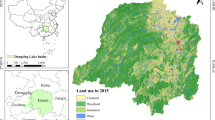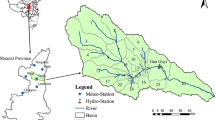Abstract
Although the importance of addressing economic values of ecosystem services in ecological planning and decision-making is evident, substantial practical challenges still remain. In particular, methods to identify spatial priority areas for the provision of hydrological ecosystem services across watershed need to be developed. Spatial priority areas are those locations which provide high benefits from one or more ecosystem service. Here we mapped a set of ecosystem services from hydrology model (Soil and Water Assessment Tool) and delineated priority areas from Zonation model according to different economic cost layer scenarios. Each economic cost layer scenario was produced by a set of water yields allocated to different utilizations for socio-economic development and corresponds to different water resources exploitation strategies which different stakeholders could undertake. Using the northernmost of Japan (Teshio watershed) as a case study, we processed grid maps of key individual and multiple ecosystem services including water yield, and inorganic and organic nutrient retentions, and also explored their spatial distribution patterns. Finally, we showed spatial priority areas for individual and multiple hydrological ecosystem services using different economic cost layers which corresponded to different water resources utilization. Our results are as follows: (i) there were two main spatial distribution patterns of ecosystem services in this study site, water yield, and organic nutrient and sediment retention services (concentrated in northern, southeastern and southwestern locations of study watershed) and inorganic nutrient retention services (concentrated in agricultural lands and riparian areas); (ii) tremendous changes took place in the spatial patterns of priority areas for individual and multiple ecosystem services with considering different economic costs; (iii) it is important to simultaneously consider individual and multiple ecosystem services under different economic costs in identifying spatial priority areas. Different economic cost layer scenarios provoke drastic changes in the delineation of priority areas, and therefore decision-making processes need to carefully consider the relative economic values attributed to different services for regional ecosystem management and planning.

















Similar content being viewed by others
References
Alibuyog NR, Ella VB, Reyes MR, Srinivasan R, Heatwole C, Dillaha T (2009) Predicting the effects of land use change on runoff and sediment yield in Manupali River sub-watersheds using the SWAT model. Int Agric Eng J 18:15–25
Anderson BJ, Armsworth PR, Eigenbrod F et al (2009) Spatial covariance between biodiversity and other ecosystem service priorities. J Appl Ecol 46:888–896
Ando A et al (1998) Species distributions, land values, and efficient conservation. Science 279:2126–2128
Arnold JG, Allen PM (1996) Estimating hydrologic budgets for three Illinois watersheds. J Hydrol 176:57–77
Aznarez C, Jimeno-Sáez P, López-Ballesteros A, Pacheco JP, Senent-Aparicio J (2021) Analysing the impact of climate change on hydrological ecosystem services in Laguna del Sauce (Uruguay) using the SWAT model and remote sensing data. Remote Sens 13:2014
Balmford A, Long A (1994) Avian endemism and forest loss. Nature 372:623–624
Balmford A et al (2001) Conservation conflicts across Africa. Science 291:2616–2619
Balmford A et al (2000) Integrating conservation costs into international priority setting. Conserv Biol 11:597–605
Balmford A, Fisher B, Green RE, Naidoo R, Strassburg B, Kerry Turner R, Rodrigues ASL (2011) Bringing ecosystem services into the real world: an operational framework for assessing the economic consequences of losing wild nature. Environ Resour Econ 48:161–175
Brown AE, Zhang L, McMahon TA, Western AW, Vertessy RA (2005) A review of paired catchment studies for determining changes in water yield resulting from alterations in vegetation. J Hydrol 310:28–61
Cabeza M, Moilanen A (2003) Site-selection algorithms and habitat loss. Conserv Biol 17:1402–1413
Cabeza M, Moilanen A (2006) Replacement cost: a practical measure of site value for cost-effective reserve planning. Biol Cons 132:336–342
Casalegno S, Bennie JJ, Inger R, Gaston KJ (2014) Regional scale prioritisation for key ecosystem services, renewable energy production and urbandevelopment. PLoS ONE 9(9):e107822
Chan KMA, Hoshizaki L, Klinkenberg, (2011) Ecosystem services in conservation planning: targeted benefits vs. co-benefits or costs? PLoS Biology 6(9):e24378-1–14
Chan KMA, Shaw MR, Cameron DR, Underwoood EC, Daily GC (2006) Conservation planning for ecosystem services. PLoS Biology 4(11):e379-2138–2152
Cimon-Morin J, Darveau M, Poulin M (2013) Fostering synergies between ecosystem services and biodiversity in conservation planning: a review. Biol Conserv 166:144–154
Costanza R, d’Arge R, de Groot R et al (1997) The value of the world’s ecosystem services and natural capital. Nature 387:253–259
Dagher-Kharrat MB, Zein HE, Rouhan G (2018) Setting conservation priorities for Lebanese flora-identification of important plant areas. J Nat Conserv 43:85–94
Daily GC, Polasky s, Goldstein G, et al (2009) Ecosystem services in decision making: time to deliver. Front Ecol Environ 7(1):21–28
Degroot RS, Alkemade R, Braat L, Hein L, Willemen L (2010) Challenges in integrating the concept of ecosystem services and values in landscape planning, management and decision making. Ecol Complex 7:260–272
Fan M, Shibata H (2014) Spatial and temporal analysis of hydrological provision ecosystem services for watershed conservation planning of water resources. Water Resour Manage 28:3619–3636
Fan M, Shibata H (2015) Simulation of watershed hydrology and stream water quality under land use and climate change scenarios in Teshio River watershed, northern Japan. Ecol Indic 50:79–89
Fan M, Shibata H, Chen L (2018a) Spatial priority conservation areas for water yield ecosystem service under climate change scenarios in Teshio watershed, northernmost of Japan (In Press). J Water Clim Change
Fan M, Shibata H, Chen L (2018b) Reconciling spatial conservation of multiple hydrological ecosystem services across Teshio Watershed, Northern Japan. J Water Resour Plann Manage 144(2):05017022
Fan M, Shibata H, Wang Q (2016) Optimal conservation planning of multiple hydrological ecosystem services under land use and climate changes in Teshio river watershed, northernmost of Japan. Ecol Ind 62:1–13
Fitzpatrick FA, Scudder BC, Lenz BN, Sullivan DJ (2001) Effects of multi-scale environmental characteristics on agricultural stream biota in eastern Wisconsin. J Am Water Resour Assoc 37:1489–1507
Gordon A, Simondson D, White M, Moilanen A, Bekessy SA (2009) Integrating conservation planning and landuse planning in urban landscapes. Lands Urban Plan 91(4):183–194
Haverkamp S, Fohrer N, Frede HG (2005) Assessment of the effect of land use patterns on hydrologic landscape functions: a comprehensive GIS-based tool to minimize model uncertainty resulting from spatial aggregation. Hydrol Process 19:715–727
Ileva NY, Shibata H, Satoh F, Sasa K, Ueda, (2009) Relationship between the riverine nitrate-nitrogen concentration and the land use in the Teshio River watershed, North Japan. Sustain Sci 4:189–198
Kaplowitz MD, Lupi F, Arreola O (2012) Local markets for payments for environmental services: can small rural communities self-finance watershed protection? Water Resour Manag 26:3689–3740
Kremen C, Cameron A, Moilanen A et al (2008) Aligning conservation priorities across Taxa in Madagascar with high-resolution planning tools. Science 320(5873):222–226
Kukkala AS, Moilanen A (2017) Ecosystem services and connectivity in spatial conservation prioritization. Landsc Ecol 32(1):1–10
Leathwick J, Moilanen A, Francis M, Elith J, Taylor P, Julian K, Hastie T, Duffy C (2008) Novel methods for the design and evaluation of marine protected areas in offshore waters. Conserv Lett 1(2):91–102
Legesse D, Vallet-Coulomb C, Gasse F (2003) Hydrological response of a catchment to climate and land use changes in Tropical Africa: case study South Central Ethiopia. J Hydrol 275:67–85
Lenat DR, Crawford JK (1994) Effects of land use on water quality and aquatic biota of three North Carolina Piedmont streams. Hydrobiologia 294(3):185–200
Marshall E, Randhir T (2008) Effect of climate change on watershed system: a regional analysis. Clim Change 89:263–280
Mikusinski G, Pressey RL, Edenius L, Kujala H, Moilanen A, Niemelä J, Ranius T (2007) Conservation planning in forest landscape of Fennoscandia and an approach to the challenge of countdown 2010. Conserv Biol 21(6):1445–1454
Millennium Ecosystem Assessment (2005) Ecosystems and human well-being: biodiversity synthesis. World Resources Institute, Washington DC (USA)
Mishima S, Endo A, Kohyama K (2010) Nitrogen and phosphorus balance on crop production in Japan on national and prefectural scales. Nutr Cycl Agroecosyst 87:159–173
Mitchell MGE, Bennett EM, Gonzalez A (2015) Strong and nonlinear effects of fragmentation on ecosystem service provision at multiple scales. Environ. Res. Lett. 10(9):094014
Moilanen A (2007) Landscape zonation, benefit functions and target-based planning: unifying reserve selection strategies. Biol Conserv 134(4):571–579
Moilanen A, Arponen A, Stockland JN, Cabeza M (2009) Assessing replacement cost of conservation areas: how does habitat loss influence priorities? Biol Conserv 142:575–585
Moilanen A, Franco AMA, Early RI, Fox R, Wintle B, Thomas CD (2005) Prioritizing multiple-use landscapes for conservation: methods for large multi-species planning problems. Proc R Soc B 272:1885–1891
Naidoo R, Adamowicz WL (2005) Modeling opportunity costs of conservation in transitional landscapes. Conserv Biol 20(2):490–500
Naidoo R, Balmford A, Ferraro PJ, Polasky S, Ricketts TH, Rouget M (2006) Integrating economic costs into conservation planning. Trends Ecol Evol 21(12):681–687
Nelson E, Mendoza G, Regetz J et al (2009) Modeling multiple ecosystem services, biodiversity conservation, commodity production, and tradeoffs at landscape scales. Front Ecol Environ 7(1):4–11
Pereira HM, Daily GC (2006) Modeling biodiversity dynamics in countryside landscapes. Ecology 87:1877–1885
Schröter M, Rusch GM, Barton DN, Blumentrath S, Nordén B (2014) Ecosystem services and opportunity costs shift spatial priorities for conserving forest biodiversity. PLoS One 9:e112557
Schulp CJE, Van Teeffelen AJA, Tucker G, Verburg PH (2016) A quantitative assessment of policy options for no net loss of biodiversity and ecosystem services in the European Union. Land Use Policy 57:151–163
Stewart RRM, Possingham HP (2005) Efficiency, costs and trade-offs in marine reserve system design. Environ Model Assess 10(3):203–213
Sutton NJ, Cho S, Armsworth PR (2016) A reliance on agricultural land values in conservation planning alters the spatial distribution of priorities and overestimates the acquisition costs of protected areas. Biol Conserv 194:2–10
Tani M (1997) Runoff gegeration processes estimated from hydrological observations on a steep forested hillslope with a thin soil layer. J Hydrol 200:84–109
Trisurat Y, Alkemade R, Verburg PH (2010) Projecting land-use change and its consequences for biodiversity in Northern Thailand. Environ Manage 45:626–639
Tsukamoto Y, Ohta T (1988) Runoff process on a steep forested slope. J Hydrol 102:165–178
Verhagen W, Teeffelen AJAV, Baggio A, Poggio L, Gimona A, Verburg PH (2016) Effects of landscape configuration on mapping ecosystem service capacity: a review of evidence and a case study in Scotland. Landsc Ecol 31:1457–1479
Verhagen W, Kukkala AS, Moilanen A, van Teeffelen AJA, Verburg PH (2017) Use of demand and spatial flow in prioritizing areas for ecosystem services. Biol Conserv 31(4):860–871
Verhagen W, van Teeffelen AJA, Verburg PH (2018) Shifting spatial priorities for ecosystem services in Europe following land use change. Ecol Ind 89:397–410
Wallace KJ (2007) Classification of ecosystem services: problems and solutions. Biol Conserv 139(3–4):235–246
Watts ME, Ball IR, Stewart RS, Klein CJ, Wilson KA, Steinback C, Lourival R, Kircher L, Possingham HP (2009) Marxan with Zones: software for optimal conservation based land- and sea-use zoning. Environ Modell Softw 24-S1:1513–1521
Williams JR, Berndt HD (1977) Sediment yield prediction based on watershed hydrology. Trans ASAE 20(6):1100–1104
Williams JR, Jones CA, Dyke PT (1984) A modelling approach to determining the relationship between erosion and soil productivity. Trans ASAE 27:129–144
Williams PH et al (2003) Integrating biodiversity priorities with conflicting socio-economic values in the Guinean-Congolian forest region. Biodiv Conserv 12:1297–1320
Zhao B, Kreuter U, Li B, Ma ZJ, Chen JK, Nakagoshi N (2004) An ecosystem service value assessment of land-use change on Chongming Island, China. Land Use Policy 21:139–148
Acknowledgements
We are grateful to the editors and reviewers for fundamental improvement of this manuscript.
Funding
This study was supported by Key Research and Development Projects of Sichuan Science and Technology Plan (No. 2019YFS0057) and National Natural Science Foundation of China (No. 41601088).
Author information
Authors and Affiliations
Corresponding author
Additional information
Publisher's Note
Springer Nature remains neutral with regard to jurisdictional claims in published maps and institutional affiliations.
Supplementary Information
Below is the link to the electronic supplementary material.
Rights and permissions
About this article
Cite this article
Fan, M., Shi, M., Liu, Y. et al. Implications of spatial priority areas for hydrological ecosystem services through coupling hydrology model and Zonation model under different economic costs of water utilizations in northernmost of Japan. Mitig Adapt Strateg Glob Change 27, 2 (2022). https://doi.org/10.1007/s11027-021-09976-z
Received:
Accepted:
Published:
DOI: https://doi.org/10.1007/s11027-021-09976-z




